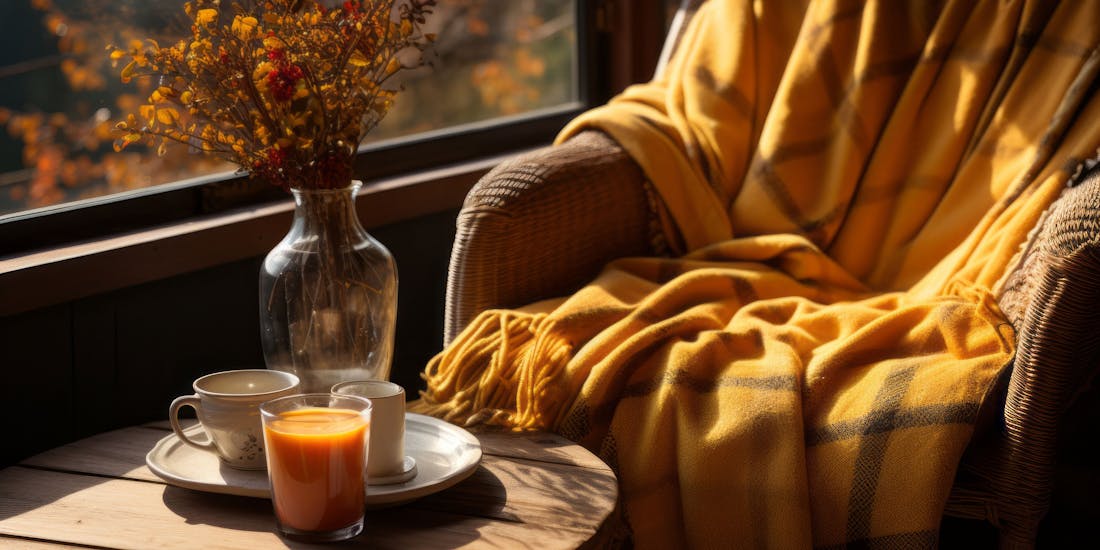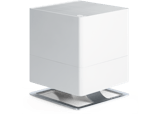
Nadine Walder, 26 September 2025
Regulating air temperature
Proper heating and airing in autumn
Autumn is a transitional season that is often accompanied by changing weather conditions. This makes it especially important to keep an eye on indoor temperature and humidity to ensure a comfortable and healthy indoor climate. In autumn, humidity can often be high when it is rainy but still warm outside. Proper airing is therefore crucial for an optimal indoor climate. In addition, the question arises as to the correct heating behaviour in autumn.
Find out in this article
- Indoor climate in autumn
- How to air properly in autumn: what to bear in mind
- Room temperature in autumn: at what outdoor temperature should I start heating?
- Devices for indoor climate in autumn
Indoor climate in autumn
In autumn, the indoor climate changes noticeably. The temperatures outside are subject to great fluctuations, the days become shorter and nature prepares for winter. These changes have a direct influence on the indoor climate of our rooms, flats or houses.
A possible side effect in autumn is increased humidity indoors. This can be due to increased precipitation. If it is still warm outside during the day, or rains a lot, and at the same time the indoor rooms are not yet heated, the humidity can become too high. Excessive indoor humidity can lead to personal discomfort and mould growth.
The opposite is true in late autumn, when it is already cold outside and the indoors are heated. Then the humidity inside drops and often becomes too low. Due to the changing weather in autumn, it is particularly important to keep an eye on the indoor climate and regulate it if necessary. The relative humidity indoors should be between 40 % to 60 %. At values below or above this, the air is too dry or too humid. Relative humidity can be easily measured with a hygrometer.
How to air properly in autumn: what to bear in mind
Proper airing in autumn is crucial to benefit from a pleasant indoor climate and optimal humidity. Due to the changeable weather conditions, flexibility in airing is necessary.
In cold autumn weather, the room should only be aired 2 to 3 times a day for a short period of time. Cross-airing makes the most sense here, as this accelerates the exchange of air. This ensures that not too much warm air is removed from the interior. As a rule of thumb, the colder it is outside, the shorter the airing time. Around five minutes of airing time for each time you open the windows is usually sufficient.
When it is warm and sunny outside, it is possible to air for a slightly longer period of time to let fresh air in. In this type of autumn weather, the rules for airing in summer can basically be followed.
Room temperature in autumn: at what outdoor temperature should I start heating?
There is no clear rule as to when the heating should be set. People have different sensations of cold and therefore the setting of the heating in autumn should be based on the individual sensation of the occupants. The usual comfort temperature is in the range of 20 to 22 °C, but some people like it a little colder or warmer. There are a few tips for creating and maintaining a pleasant and healthy indoor climate in autumn and for heating in an energy- and cost-efficient way.
In autumn, temperatures can quickly change between warm and cold. You can take advantage of sunny days and make sure that the sun shines into the rooms and warms them up naturally. In rooms with direct sunlight, the room doors should be left open so that the heat can spread. At night, windows, blinds or shutters should be closed and curtains drawn to minimise heat loss.
If the heaters are not yet running, care should be taken to ensure that the room temperature does not fall below 15 °C. As mentioned above, solar radiation can be used for this purpose. Cool room temperatures over a longer period of time - like permanently too humid air - favour mould growth. This has to do with the fact that warm air can absorb more moisture than cold air. At cold room temperatures, the moisture can no longer be bound by the air and settles in the coldest places in the room. Mould can then develop there.
If the heating is already set, care must be taken that the radiators are not covered by objects so that the heat can circulate. Otherwise, even heat radiation is prevented, which can lead to higher heating costs. There should always be a few centimeters of space between walls and furniture or objects so that the warm air can also reach here and mould does not form.
Devices for the indoor climate in autumn
Due to the changing weather conditions in autumn, various devices can help to create a pleasant indoor climate.
- Using a hygrometer to monitor the air humidity makes it possible to adjust the airing behaviour according to the relative humidity in the room. The ideal relative humidity indoors is between 40 % to 60 %.
- When humidity levels become too high indoors due to precipitation and still warm temperatures, dehumidifiers can help to reduce and maintain humidity at an optimal level. Towards the end of autumn, it can already be very cold, and the air can therefore be too dry. Humidifiers help to increase the air humidity.
- When it is cold outside, but the central heating is not yet running, fan heaters are a practical solution for warming individual rooms.
Fan heater with flame effect
Do you long to relax in front of a cosy open fire on chilly days? ErikErik combines electric fireplace, fan heater and aroma diffuser in one device. The flame effect is safe and soot-free. The functions can be used individually or in combination. As an aroma diffuser, Erik diffuses your chosen scent throughout the room. If you need warmth, use him as a fan heater. If you want to enjoy the beautiful, safe open fire, use Erik as an electric fireplace.
Overall, the indoor climate in autumn is an exciting challenge. However, with the right knowledge and measures, you can ensure that your home remains a cosy and healthy place during this season.
If you have questions related to indoor room climate, please get in touch with us. Or subscribe to our newsletter to regularly get informed about current topics regarding indoor climate, experience reports or Stadler Form insights.








